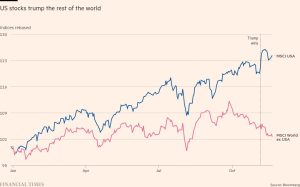does it pay to be a company lifer?
“Nike has always been a core part of who I am,” said Elliott Hill when the sportswear company anointed him chief executive last month. This was not pure spin. After all, Hill started at Nike as an intern.
The appointment is a vote of confidence in the “CEO lifer”, a small cohort of top executives including General Motors’ Mary Barra; Dave McKay at Canadian bank RBC; and Walmart’s Doug McMillon, who have risen through the ranks of their companies over the course of many years.
Hill has spent his working life at Nike, except for a spell as a trainer at the Dallas Cowboys American football team. By selecting him to succeed John Donahoe, who had come from a tech background, previously leading eBay, the US company signalled a renewed focus on core products and a commitment to its culture.
Company lifers can bring substantial advantages to a business, says Claudius Hildebrand, co-author of The Life Cycle of a CEO and consultant at Spencer Stuart, the executive search firm. “They foster continuity and enhance morale, as employees see clear pathways for their progression, which cultivates loyalty.” They have established relationships with shareholders, financiers and customers.
The risk, however, is that executives who have spent their whole career in one company may have tunnel vision and stifle innovation due to a lack of exposure to outside ideas and influences.


Institutional knowledge is a key asset for leaders, says Marco Amitrano, senior partner of PwC UK, who started as a graduate in the professional service firm’s Newcastle office and worked his way up to succeed Kevin Ellis this summer. He says this experience has given him the ability to understand the “organisation inside out. You know the culture and how it feels at every level of the firm. Employees know you understand what it takes to succeed . . . and that helps build trust and rapport.” He notes that it also means leaders have stuck around long enough to see the impact of initiatives, potentially increasing accountability.
Monika Hamori, associate professor of human resource management at IE Business School, says there are some instances where leaders with external experience may be more useful than those who grew up in the organisation. These might include “companies needing deep strategic changes, a turnaround, [or] companies in fast-changing industries”.
However, businesses that do appoint an outsider who lacks company-specific experience can underestimate the impact of disruption. At times, these hires can destabilise the top management team and risk “bringing routines and knowledge that used to work well in another organisation but may be a complete failure in a new company context”, adds Hamori.
Data from Altrata shows that a quarter of current FTSE 100 chief executives are externally appointed, compared with 15 per cent of S&P 500 leaders.
The most common amount of time internal CEO appointments had worked at their company was between six and 10 years, according to Altrata. Among the largest US companies, 20 per cent of chief executives had spent more than 21 years at their company, while 7 per cent in the UK had been there that long. One per cent of S&P 500 CEOs had worked at the same company for more than 41 years.
“In the US, there is a substantial number of CEOs who were in the organisation for 30 years before they assumed the CEO position,” says Maya Imberg at Altrata.
Most of these people would have held many different roles within their company, giving them a breadth of experience that external hires may lack. Hill, for example, has worked in more than a dozen roles at Nike, from a member of the sales team specialising in sports graphics to vice-president of global retail.
“The world’s largest [companies] are enormous, often have products that are very different, have multiple brand names [and are in] multiple countries,” says Kimberly Whitler, associate professor of business administration at the University of Virginia’s Darden School of Business. “Understanding the complexity of such an organisation is best if you have extensive experience in different geographies and functions.”
Duncan Wanblad, chief executive of Anglo American, who has worked for the mining group for more than 30 years, points to his own experiences in “a variety of roles, and in different countries”. His career has included leading strategy and business development and positions in the company’s metals businesses in South America and South Africa, in addition to an array of engineering and projects roles earlier in his career. He says this has given him “the opportunity to work alongside and learn from diverse colleagues with a tremendous breadth of skill sets and experience”.
He adds: “Diverse experience is critical [for a leader], yes, but it is absolutely possible to obtain this in one company.”
Some CEOs seek out other opportunities to gain external experience. Roy Twite, chief executive of engineering company, IMI, who joined on the company’s graduate scheme in 1988 and has worked across markets including the US, UK and Sweden, says: “You have to find ways to experience other companies.” He points to his own stint as a non-executive director on the board of Halma, a technology company operating in safety and healthcare. He has also created networks, including finding mentors, and is part of a group of 11 CEOs “that get together on a quarterly basis to see if they are investing [in the] right things”.
Education is another stimulus, says Twite, who has continued his professional development at Cambridge and Harvard universities.
Hamori points to the importance of complementing a CEO with a top management team that has a more diverse background. “Executives with different prior industry or company affiliations could help counterbalance the skill sets of a CEO who grew up in a single firm,” she says. Fresh perspectives may also come from customers or staff. Amitrano says: “Employees are often the best at challenging or seeing things differently.” With this in mind, he has established a formal shadow leadership team, made up of 12 individuals from ranks within the firm, to feed employee views into board decisions.
Some still argue that the best way to progress in a career is by moving around companies. More than 10 years ago, Reid Hoffman, founder of LinkedIn, co-authored an article that argued: “You can’t have an agile company if you give employees lifetime contracts — and the best people don’t want one employer for life anyway.” Job hopping is a clear way to boost salary and accelerate promotion.
The danger for corporate veterans, says RJ Bannister, partner at Farient Advisors, the executive pay advisory company, is that “if someone has been at an organisation for a while, they might be stereotyped. You might not necessarily see them as the individual they are [but] the person they were when hired. An individual might have to leave to prove themselves.”
But CEO lifers argue that staying in a company accrues social capital and helps executives acquire the skills to navigate an organisation.
When Twite was younger he was given the simple advice to “build a career. If you get stuck and feel you’ve learnt as much as you can then think about moving.”
He says he has been approached by headhunters over the years but “thought [IMI] was the sort of company that would recognise [doing a good job]. If you go somewhere else, you have to develop your reputation, starting again. The grass isn’t always greener.”
#pay #company #lifer








